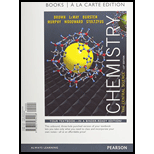
Chemistry: The Central Science, Books a la Carte Edition & Modified Mastering Chemistry with Pearson eText -- ValuePack Access Card Package
1st Edition
ISBN: 9780133910919
Author: Theodore E. Brown, H. Eugene LeMay, Bruce E. Bursten, Catherine Murphy, Patrick Woodward, Matthew E. Stoltzfus
Publisher: PEARSON
expand_more
expand_more
format_list_bulleted
Textbook Question
Chapter 19, Problem 99AE
(a) For each of the following reactions, predict the sign of AH’ and AS0 without doing any calculations, (b) Rased on your general chemical knowledge, predict which of these reactions will have ff > 1. (c) In each case indicate whether K should increase or decrease with increasing tempie rature.
(1) 2±Mg(s> + O2(g) = aMgOfj)
(ii) 2KI(s) = 2K(g) + I2(f)
(iii) Naa(f) 2Na(^)
(iv) 2V,O5(s) = 4 V(j) + SO2(j)
Expert Solution & Answer
Want to see the full answer?
Check out a sample textbook solution
Students have asked these similar questions
Pls help me on this q.
Given the elementary reactions in an aqueous medium with an ionic strength of 0.001:1) CH3Br + OH- → CH3OH + Br-2) ClCH2COO- + OH- → HOCH2COO- + Cl-3) [Co(NH3)5Br]2+ + NO2- →[Co(NH3)5NO2]2+ + Br-If the ionic strength is decreased, 1) k will not change; 2) k will decrease; and 3) k will increase. Is this correct?
Relate zero ionic strength and infinite dilution limit.
Chapter 19 Solutions
Chemistry: The Central Science, Books a la Carte Edition & Modified Mastering Chemistry with Pearson eText -- ValuePack Access Card Package
Ch. 19.1 - The process of iron being oxidized to make...Ch. 19.1 - Prob. 19.1.2PECh. 19.2 - Do all exothermic phase changes have a negative...Ch. 19.2 - Prob. 19.2.2PECh. 19.3 - Prob. 19.3.1PECh. 19.3 - Prob. 19.3.2PECh. 19.3 - Suppose you have two 1-L flasks, one containing N2...Ch. 19.3 - Prob. 19.4.2PECh. 19.4 -
10.8
Place the following gases in order of...Ch. 19.4 - Prob. 19.5.2PE
Ch. 19.5 - Prob. 19.6.1PECh. 19.5 - Prob. 19.6.2PECh. 19.5 - Prob. 19.7.1PECh. 19.5 - Prob. 19.7.2PECh. 19.5 - Prob. 19.8.1PECh. 19.5 - Prob. 19.8.2PECh. 19.6 - Prob. 19.9.1PECh. 19.6 - Prob. 19.9.2PECh. 19.7 - Prob. 19.10.1PECh. 19.7 - Prob. 19.10.2PECh. 19.7 - Prob. 19.11.1PECh. 19.7 - Prob. 19.11.2PECh. 19.7 - Prob. 19.12.1PECh. 19.7 - Prob. 19.12.2PECh. 19 - Prob. 1DECh. 19 - Prob. 1ECh. 19 - Prob. 2ECh. 19 - Prob. 3ECh. 19 - Prob. 4ECh. 19 - Prob. 5ECh. 19 - Prob. 6ECh. 19 - 11.47 Indicate whether each statement is true or...Ch. 19 - Prob. 8ECh. 19 - Prob. 9ECh. 19 - Prob. 10ECh. 19 - Prob. 11ECh. 19 - Prob. 12ECh. 19 - Prob. 13ECh. 19 - Prob. 14ECh. 19 - A glass vessel fitted with a stopcock valve has a...Ch. 19 - Prob. 16ECh. 19 - Prob. 17ECh. 19 - Prob. 18ECh. 19 - Prob. 19ECh. 19 - Prob. 20ECh. 19 - Prob. 21ECh. 19 - Consider what happens when a sample of the...Ch. 19 - Prob. 23ECh. 19 - Prob. 24ECh. 19 - The normal boiling point of Br2(l) is 58.8 °C, and...Ch. 19 - Prob. 26ECh. 19 - Prob. 27ECh. 19 - Prob. 28ECh. 19 - Prob. 29ECh. 19 - Prob. 30ECh. 19 - Prob. 31ECh. 19 - Prob. 32ECh. 19 - Prob. 33ECh. 19 - Prob. 34ECh. 19 - 19.35 (a) What do you expect for the sign of ∆S in...Ch. 19 - Prob. 36ECh. 19 - Prob. 37ECh. 19 - Prob. 38ECh. 19 - Prob. 39ECh. 19 - Prob. 40ECh. 19 - For each of the fallowing pairs, choose the...Ch. 19 - Prob. 42ECh. 19 - Prob. 43ECh. 19 - Prob. 44ECh. 19 - Prob. 45ECh. 19 - Prob. 46ECh. 19 - Prob. 47ECh. 19 - Cyclopropane and propylene are isomers that both...Ch. 19 - Prob. 49ECh. 19 - Prob. 50ECh. 19 - Prob. 51ECh. 19 - Prob. 52ECh. 19 - Prob. 53ECh. 19 - Prob. 54ECh. 19 - Prob. 55ECh. 19 - Prob. 56ECh. 19 - Prob. 57ECh. 19 - Prob. 58ECh. 19 - Using data in Appendix C, calculate HO, SO,...Ch. 19 - Prob. 60ECh. 19 - Prob. 61ECh. 19 - Prob. 62ECh. 19 - Prob. 63ECh. 19 - Prob. 64ECh. 19 - Prob. 65ECh. 19 - From the values given for H° and S°, calculate G°...Ch. 19 - Prob. 67ECh. 19 - Prob. 68ECh. 19 - Prob. 69ECh. 19 - Prob. 70ECh. 19 - Prob. 71ECh. 19 - Prob. 72ECh. 19 - (a) Use data in Appendix C to estimate the boiling...Ch. 19 - Prob. 74ECh. 19 - Prob. 75ECh. 19 - Prob. 76ECh. 19 - Prob. 77ECh. 19 - Prob. 78ECh. 19 - Consider the reaction 2 NO2(g) (N2O4(g). (a)...Ch. 19 - Prob. 80ECh. 19 - Prob. 81ECh. 19 - Prob. 82ECh. 19 - Prob. 83ECh. 19 - Prob. 84ECh. 19 - Prob. 85ECh. 19 - The Kb, for methylamine (CH3NH2) at 25oC is given...Ch. 19 - Prob. 87AECh. 19 - Prob. 88AECh. 19 - Prob. 89AECh. 19 - Prob. 90AECh. 19 - Prob. 91AECh. 19 - Prob. 92AECh. 19 - Prob. 93AECh. 19 - Prob. 94AECh. 19 - Prob. 95AECh. 19 - Prob. 96AECh. 19 - Consider the following three reactions: (i) Ti (s)...Ch. 19 - Prob. 98AECh. 19 - (a) For each of the following reactions, predict...Ch. 19 - Prob. 100AECh. 19 - Prob. 101AECh. 19 - Prob. 102AECh. 19 - Prob. 103AECh. 19 - Prob. 104AECh. 19 - Prob. 105AECh. 19 - Prob. 106AECh. 19 - Most liquids follow Trouton’s rule (see Exercise...Ch. 19 - 19.108 In chemical kinetics the entropy of...Ch. 19 - Prob. 109IECh. 19 - Prob. 110IECh. 19 - Prob. 111IECh. 19 - Prob. 112IECh. 19 - The following data compare the standard enthalpies...Ch. 19 - Prob. 114IECh. 19 - Prob. 115IECh. 19 - Prob. 116IE
Knowledge Booster
Learn more about
Need a deep-dive on the concept behind this application? Look no further. Learn more about this topic, chemistry and related others by exploring similar questions and additional content below.Similar questions
- The photolysis of H3C–N=N–C2H5 involves the breaking of the single bonds shown. According to this, in addition to N2, what products would be obtained primarily if the reaction were carried out in the gas phase or in solution in an inert solvent?arrow_forwardGiven a keto-enol tautomerization reaction, which is greatly influenced by the type of solvent, indicate which of the following solvent properties cannot be considered a "solvent effect"?(A) Dielectric constant(B) Polarity(C) Hydrogen bonding capacity(D) Temperaturearrow_forwardIn solution reactions, what does "solvent effect" mean?arrow_forward
- How to solvearrow_forwardIndicate the concentration and ionic strength ranges to which the Debye-Huckel equation can be applied. And the Davies equation?arrow_forwardIf the ionic strength (I) of a solution is very low, the Debye-Huckel equation is used. If I is higher, the Davies equation is used. What is the correct value for I to use one or the other?arrow_forward
- In both the Debye-Huckel equation and the Davies equation, there is a constant A. I see that sometimes it appears as 0.51 and other times as 1.02. Explain why one or the other value is used.arrow_forwardThe two equations are forms of the Davies equation, used in thermodynamics for activity coefficients: ال log Y₁ = -Az² - 0,31 log = Az² - 0,31 1 + √Ĩ 1 + √√ k These equations are consistent and imply that Yi = Is this last equation correct? karrow_forwardThe two equations are forms of the Davies equation, used in thermodynamics for activity coefficients: ال log Y₁ = -Az² - 0,31 log = Az² - 0,31 1 + √Ĩ 1 + √√ k These equations are consistent and imply that Yi = Is this last equation correct? karrow_forward
- For the Davies equation, both expressions are correct: log Y₁ = -Az² √i - 0,31 1 + √ k log- = Az - 0,31 k 1 + √Ĩarrow_forwardk In Davies' equation log y₁ = log- log y₁ = log | = -Az² + ✓// k A is a constant that always equals 1.02. Correct? - 0,31arrow_forwardIndicate whether the equality is true Yi How is it obtained? k%arrow_forward
arrow_back_ios
SEE MORE QUESTIONS
arrow_forward_ios
Recommended textbooks for you
 Chemistry: Principles and ReactionsChemistryISBN:9781305079373Author:William L. Masterton, Cecile N. HurleyPublisher:Cengage Learning
Chemistry: Principles and ReactionsChemistryISBN:9781305079373Author:William L. Masterton, Cecile N. HurleyPublisher:Cengage Learning Principles of Modern ChemistryChemistryISBN:9781305079113Author:David W. Oxtoby, H. Pat Gillis, Laurie J. ButlerPublisher:Cengage Learning
Principles of Modern ChemistryChemistryISBN:9781305079113Author:David W. Oxtoby, H. Pat Gillis, Laurie J. ButlerPublisher:Cengage Learning Chemistry: Principles and PracticeChemistryISBN:9780534420123Author:Daniel L. Reger, Scott R. Goode, David W. Ball, Edward MercerPublisher:Cengage Learning
Chemistry: Principles and PracticeChemistryISBN:9780534420123Author:Daniel L. Reger, Scott R. Goode, David W. Ball, Edward MercerPublisher:Cengage Learning ChemistryChemistryISBN:9781305957404Author:Steven S. Zumdahl, Susan A. Zumdahl, Donald J. DeCostePublisher:Cengage Learning
ChemistryChemistryISBN:9781305957404Author:Steven S. Zumdahl, Susan A. Zumdahl, Donald J. DeCostePublisher:Cengage Learning Chemistry: An Atoms First ApproachChemistryISBN:9781305079243Author:Steven S. Zumdahl, Susan A. ZumdahlPublisher:Cengage Learning
Chemistry: An Atoms First ApproachChemistryISBN:9781305079243Author:Steven S. Zumdahl, Susan A. ZumdahlPublisher:Cengage Learning

Chemistry: Principles and Reactions
Chemistry
ISBN:9781305079373
Author:William L. Masterton, Cecile N. Hurley
Publisher:Cengage Learning

Principles of Modern Chemistry
Chemistry
ISBN:9781305079113
Author:David W. Oxtoby, H. Pat Gillis, Laurie J. Butler
Publisher:Cengage Learning

Chemistry: Principles and Practice
Chemistry
ISBN:9780534420123
Author:Daniel L. Reger, Scott R. Goode, David W. Ball, Edward Mercer
Publisher:Cengage Learning

Chemistry
Chemistry
ISBN:9781305957404
Author:Steven S. Zumdahl, Susan A. Zumdahl, Donald J. DeCoste
Publisher:Cengage Learning

Chemistry: An Atoms First Approach
Chemistry
ISBN:9781305079243
Author:Steven S. Zumdahl, Susan A. Zumdahl
Publisher:Cengage Learning

Chemical Equilibria and Reaction Quotients; Author: Professor Dave Explains;https://www.youtube.com/watch?v=1GiZzCzmO5Q;License: Standard YouTube License, CC-BY